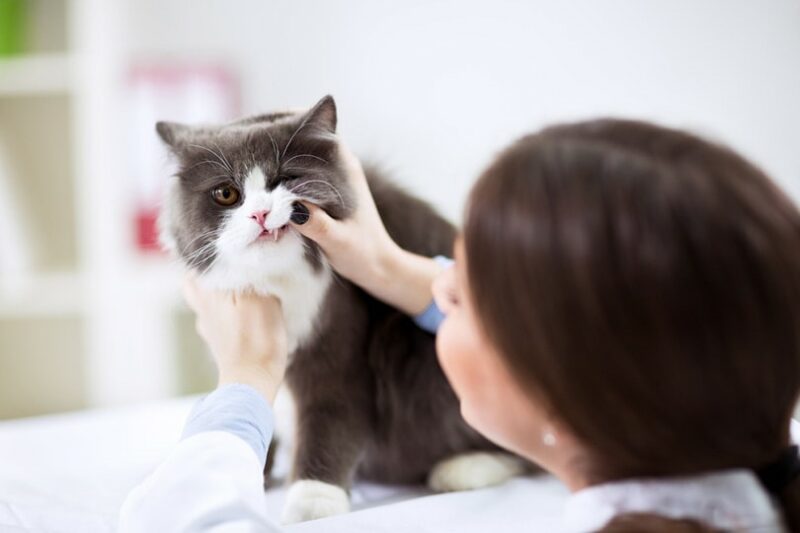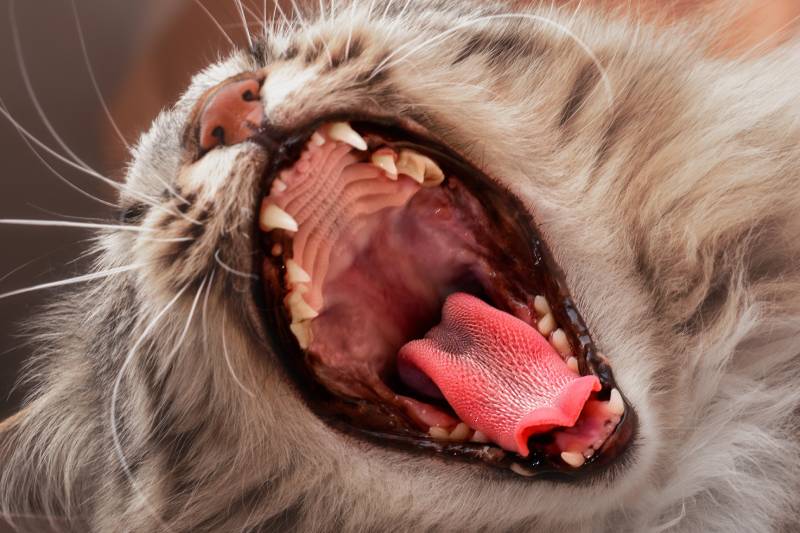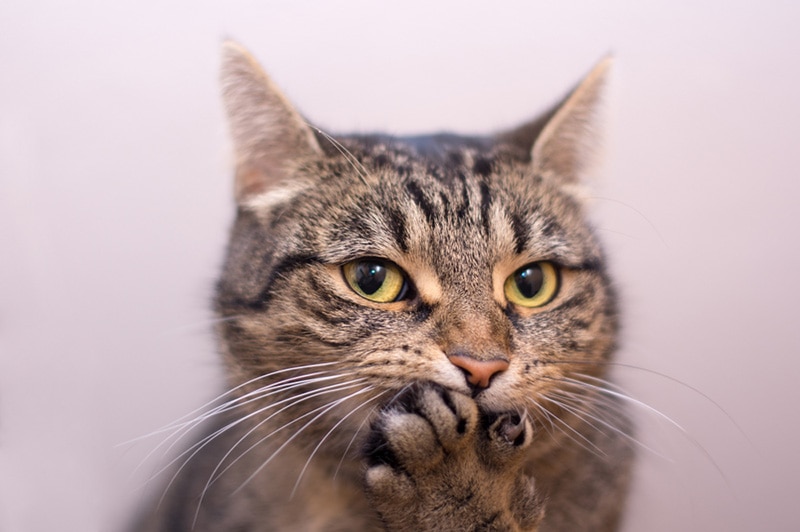
Cats can be mysterious creatures for a lot of reasons, least of all their strange and seemingly random behaviors. One behavior that is common in dogs but not in cats is drooling. This unpleasant behavior might be easy to brush off as your cat being a weirdo, but if your cat begins drooling, it’s important that you investigate the cause. The causes of feline drooling range from brief non-emergencies to true emergencies. There are a few reasons your cat may be drooling, so let’s check them out.
The 6 Reasons Why Your Cat is Suddenly Drooling
1. Dental Problems
| Type of problem: | Dental/Oral |
| Severity: | Moderate to severe |
| Treatment: | Veterinary dental care |
One of the most common causes of drooling in cats is dental problems. This is most commonly caused by dental disease, which can leave your cat with painful teeth and gums. The two other major dental or oral issues that can cause drooling are ulcers from chemical or electrical burns, or tumors under the tongue and on the gums.
While dental disease isn’t usually an emergency situation, it can be extremely painful and unpleasant for your cat and should be evaluated by a veterinarian as soon as you can get your cat in for an appointment. If your vet clinic needs to schedule your cat’s appointment out by a few days or weeks, you should tell them your cat has begun drooling and they may want to see them sooner. Broken teeth with visible pulp, oral tumors, tongue lacerations, and dental abscesses should be seen by your vet within 24 hours, ideally.

2. Bad Tastes
| Type of problem: | Oral |
| Severity: | Mild |
| Treatment: | Monitoring |
Like humans, cats will make it very obvious if they taste something they find to be unpleasant. While people may vocalize their distaste or stick out their tongue, your cat may begin drooling.
Drooling is the body’s way of defending against dangerous things that may get into your cat’s mouth, so if your cat tastes something bitter or otherwise unpleasant, they are likely to experience this response since their body won’t know the difference between an unpleasant tasting treat and a threat.
Drooling because of bad taste is most often associated with things like medications. If you’re giving your cat medication by mouth, they may drool as soon as you give it as part of their attempt to get the medication and taste out of their mouth. The other common cause of icky tastes in cats is the tendency of cats to chew on plants. Although a plant can be non-toxic to cats, it can have an unpleasant taste when chewed on, leading your cat to drool.
3. Oral Toxins
| Type of problem: | Toxicity |
| Severity: | Moderate to severe |
| Treatment: | Veterinary intervention |
As previously mentioned, cats have a habit of chewing on plants they shouldn’t, along with a variety of other things. This causes cats to ingest toxic substances, some of which can be deadly.
Your cat may begin drooling as soon as they experience an unpleasant taste or sensation in their mouth from a toxin, but that doesn’t mean your cat doesn’t need to see a vet. If your cat consumes anything you know is a toxin, you need to get them to the vet immediately. If your cat consumes something you are unsure of, then you should contact the pet poison control hotline or your vet’s office immediately for guidance.
To prevent your cat from consuming toxins, you should always aim to keep toxic substances out of the reach of your cat. This rule applies to most houseplants, medications, cleaning chemicals, and pesticides. Work to investigate plants before you bring them home to prevent a known toxin from entering your home in the first place. Keep dangerous substances behind locked doors, using baby cabinet locks if necessary to keep a curious cat out. Medications and OTC supplements should be kept properly sealed and out of the reach of your cat.

4. Foreign Objects
| Type of problem: | Oral |
| Severity: | Mild to severe |
| Treatment: | Removal of the object |
Foreign objects wedged in the mouth are more common in dogs than in cats, but cats are far from immune. Oral foreign objects can be anything from food or treats that become wedged to household items your cat attempted to chew on or consume. Sewing needles and fish hooks are other common oral foreign objects in cats, which are exceptionally dangerous because they can do significant damage to the body and cause infections.
Most cats experiencing a foreign object in their mouth will show multiple signs, not just drooling. Usually, cats will paw or scratch at their mouth and face in an attempt to get the item out. They may also yowl, aggressively rub their face against objects, or even run and hide.
Some foreign objects can quickly and easily be removed by your cat, sometimes requiring a little assistance from people. However, many foreign objects need veterinary care to remove. Objects that are stuck in a cat’s mouth often need to be removed under sedation.
5. Nausea
| Type of problem: | Gastrointestinal |
| Severity: | Mild to severe |
| Treatment: | Variable |
Oftentimes, cats that experience nausea, vomiting, stomach discomfort, and other gastrointestinal symptoms will drool excessively. This behavior is usually accompanied by guarding of the abdomen, arching of the back, anorexia, lethargy, and hiding. There are a ton of reasons cats can become nauseated.
Some cats may become nauseated when they need to vomit up a hairball, which is not anything to be particularly concerned about unless it is happening regularly. However, there are some extremely concerning causes of nausea in cats, including infections, tumors and cancer, and digestive blockages. If you suspect any of these things may be causing your cat to be nauseated and drool, you need to talk to your vet immediately and discuss an appointment.
If your cat has consumed string, floss, twine, or ponytail holders, they may have a blockage, which can be a medical emergency and should be assessed immediately.

6. Happiness
| Type of problem: | The good kind |
| Severity: | None |
| Treatment: | More scritches |
It may be a pleasant surprise to you to know that some cats will drool when they’re happy or content. This commonly occurs when a cat is purring and relaxed. This is the best-case scenario for your cat to be drooling. In some cats, happy drooling may become excessive, leaving a wet spot on your clothes or couch.
This behavior is usually not a sudden change, though, so if your 6-year-old cat started drooling when they purr for the first time today, it’s a good idea to get a vet visit to rule out any problems. Keep in mind that some cats purr when they are in pain, sick, or stressed, so if excessive drooling with purring is a new behavior in your cat, your vet will be able to determine if it’s a medical concern or a new funny behavior.
Tips for Looking in Your Cat’s Mouth
No matter how sweet and loving your cat is under normal circumstances, most cats are opposed to having the inside of their mouth examined, especially if they are uncomfortable, and they might turn on a dime, becoming a biting and scratching wildcat. If you’re in a situation where you need to examine the inside of your cat’s mouth, there are a few ways to keep yourself and your cat comfortable and safe.
The simplest way to look in a cat’s mouth is to use one hand to open the top jaw while using one or two fingers on the other hand to open the bottom jaw. This should be done gently and does not take notable force to pull off, so if you’re really having to tug, you may need to go straight to the vet. If you feel really confident that your cat isn’t going to scratch or bite you, you can tuck them under one of your arms while you’re doing this to keep them from backing away from you.
If you don’t feel confident doing the above maneuver, or you tried and weren’t successful, you may need to try something else.
One favorite thing that is used in vet clinics to keep the cat safe and calm and the people safe is by creating a “kitty burrito” (or a “purrito”, if you like puns). This essentially involves swaddling your cat in a blanket or towel in a similar manner that you would a human baby. Make sure to tuck your cat’s front paws down into the burrito and pull the blanket up around their neck, keeping it tight enough to prevent the claws from escaping but not so tight that it limits your cat’s breathing. This works best with two people, but you can attempt to do it alone and tuck your cat under your arm as previously mentioned.
If you’ve tried these things and haven’t succeeded in looking into your cat’s mouth or you looked and didn’t see anything, then a vet visit is in order. Your cat may need to be sedated for a thorough oral exam and blood work. Never put your fingers into your cat’s mouth, no matter how gentle they are. Cat bites often require human doctor intervention, and your cat may unintentionally bite you.
Conclusion
While some cats do drool when they are happy, most sudden occurrences of drooling should be investigated. If you thoroughly check your cat and still can’t determine a cause, you should at least call your vet clinic or an after-hours clinic for further guidance. A sudden onset of drooling in cats can indicate multiple things, most of them negative, so staying on top of this type of behavior is important for ensuring your cat’s health and longevity.
Featured Image Credit: Pongsak A, Shutterstock







